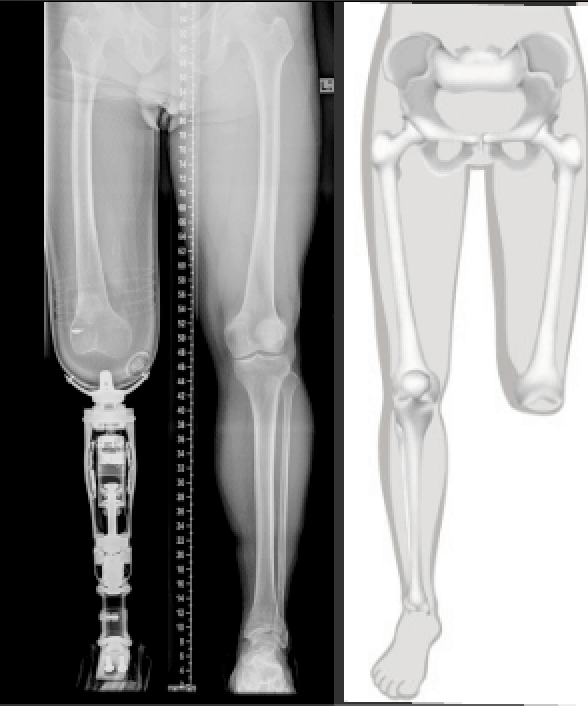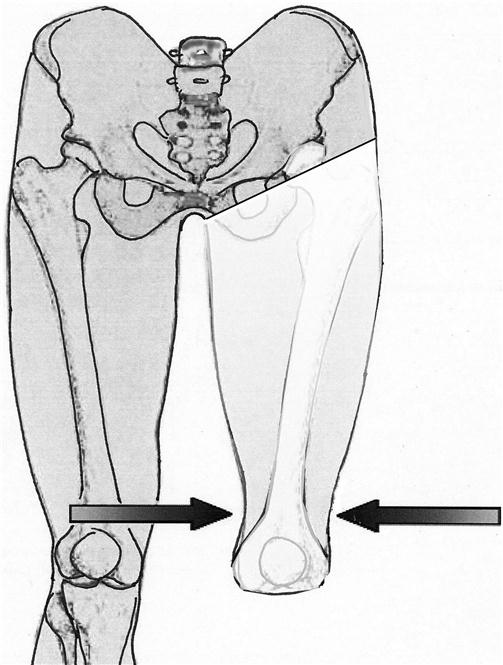Then the lower leg and foot are removed from the body. The knee disarticulation prosthetic system was designed taking into account that the amputee is able to bear weight on the end of their residual limb and long length of the limb increases their control of the prosthesis.

Advanced Socket Designs 5280 Prosthetics
In active and younger patients a knee.
. New knee joints energy - storing carbon systems such as KX06 4 Bar mechanical knee joint for active users and mobility promoting carbon system such as Clever bone for geriatric user all offer our. Before the introduction of the present day polycentric knee units sockets for the prosthesis were usually made of leather and metal hinges were used to attach the socket to the shin. Therefore less support is necessary at the top of the socket allowing for lower trim lines than a traditional transfemoral socket.
This case report describes a newly developed socket design for a world class knee disarticulation athlete. With a dual-wall design a rigid inner socket fabricated from a custom mold of the residual limb is the primary interface between the user. Traditionally upper extremity prostheses have used a dual-wall socket design fabricated from lightweight plastic or graphite composite materials.
The plate used to close the window may be displaced during the swing phase. Knee-Disarticulation Prostheses The knee-disarticulation prosthesis is very similar to the above-knee prosthesis except for the lower part of the socket and the knee mechanism. To meet the demands concerning especially the suspension of the prosthesis a new type of socket was developed.
Through-knee socket design and manufacture 103 Cleaning of the inner liner is possible in the washing machine at low temperature. This case report describes a newly developed socket design for a world class knee disarticulation athlete. A strap is fitted to provide a horizontal force to keep the window plate in place.
The new socket design further differs from traditional models in that it actu-ally consists of two parts. Clinicians work closely with each person to ensure the final product meets his or her needs. Through-Knee Amputation Disarticulation of the Knee.
This case report describes a newly developed socket design for a world class knee disarticulation athlete. The type of prosthetic knee depends on the patients. The Shape fit of the socket and selection of the individual modular components are always essential for successful treatment with a prostheses.
However these devices are too heavy for geriatric patients where a joint with voluntary. A polycentric knee joint was provided directly below the distal socket end. Socket designs which forced prosthetists to leave the prosthesis 12-inch short to achieve adequate ground clearance.
The liner simplifies construction but precludes use of condylar suspension and minimizes the benefit of distal weight-bearing. Partial-Foot Prosthetics From Toe-Disarticulation To Syme Amputation. It is the link between the residual limb and the prosthesis.
Patients are able to customize their prostheses to fit their lifestyles and design preferences. To meet the demands concerning especially the suspension of the prosthesis a new type of socket was developed. Without problems the bulky stump is fitted in an exactly moulded plastic or resin socket--eventually combined with a soft socket-- which can be easily put on and off also by older patients suffering from general.
Therefore less support is necessary at the top of the socket allowing for lower trim lines than a traditional transfemoral socket. As a result the trimline need not encapsulate the ischium with a more proximal medial trimline but can be lowered to at least one-third of the total limb length. The utility model provides a technical proposal of knee-broken artificial limb accepting chamber which comprises an accepting chamber.
These include belts straps and sleeves. This makes use of the anatomical shape of the residual limb Syme or knee disarticulation. Transtibial Prosthetics Classic Vacuum And Liner Techniques.
Recent clinical findings promote KD over TF amputations in terms of performance outcomes Penn-Barwell J. To meet the demands concerning especially the suspension of the prosthesis a. The prosthetic device which is preferably offered to knee disarticulated KD amputees is the ICRC TF prosthetic slightly modified to fit a KD socket.
A flexible bush the internal surface of which is equipped with a concave ring in opposite to the concave ring on the internal surface of the accepting chamber is arranged in. The disarticulation of the knee joint is--in contrary to the above-knee level--a fast and tender method for amputation resulting in a vigorous complete weightbearing stump. Knee joint Every prosthetic knee joint designed for knee disarticulation can be combined with this socket.
The first polycentric knee designed for knee disarticulation applications was developed at the Orthopedic Hospital Copenhagan OHC in 1969. Methods of creating suction suspension include the use of an appropriate suction socket design a gel liner suction valve and a gel sleeve. Transfemoral Liner Techniques Dynamic Knees And Feet.
Before the introduction of the present day polycentric knee units sockets for the prosthesis were usually made of leather and metal hinges were used to attach the socket to the shin. Both solutions are fully acceptable in normal everyday life but for. This is the custom made cup that fits over the residual limb.
Its design is a compromise between cost-efficiency and functionality. The socket is made from carbon fibres and polyaramid fibres and is designed with a slit in the socket creating a flexible flap. A concave ring is arranged on the internal surface of the accepting chamber.
The type of prosthetic knee depends on the patients. Knee disarticulation essentially places the biomechanic support at the base femoral condyles a skeletal loading surface which results in a more laterally displaced fulcrum. Careful design of the linkage arms results in a mechanism that appears to fold back under the thigh when sitting thus minimizing the protrusion of the knee Fig 19B-17.
The socket is made from carbon fibres and polyaramid fibres and is designed with a slit in the socket creating a flexible flap. The design lengthens the thigh piece of the prosthesis making the prosthetic knee protrusion when the patient sits. This softer inner socket increases comfort and improves the hygienic.
The knee disarticulation stump is bulbous shaped and the socket therefore often has to be equipped with a double wall soft socket or functional windows to facilitate the mounting of the prosthesis Wilde and Baumgartner 2000. The knee-disarticulation prosthesis is very similar to the above-knee prosthesis except for the lower part of the socket and the knee mechanism. In active and younger patients a knee with hydraulic swing phase control is preferred.
Various approaches have been used to securely attach a knee disarticulation prosthesis to the intact femur. In comparison to the quadrilateral socket this design better accommodates fleshy limbs and high activity patients. Every prosthetic knee joint designed for knee disarticulation can be combined with this socket.
The knee disarticulation procedure is a surgical procedure in which the tibia and fibula shin bones are separated from the femur thigh bone. The knee disarticulation prosthetic system was designed taking into account that the amputee is able to bear weight on the end of their residual limb and long length of the limb increases their control of the prosthesis. Transfemoral Prosthetics Ischial Containment Socket Design.
The ultralight frame and a flexible inner socket. One popular design employs a flexible gel liner with air expulsion inside a rigid outer socket.

Description Of Socket Reaction Moments Abbreviation Grf Ground Download Scientific Diagram

Development Of A Cosmetic Knee Disarticulation Prosthesis A Single Patient Case Study Semantic Scholar

Description Of Socket Reaction Moments Abbreviation Grf Ground Download Scientific Diagram

Knee Disarticulation Prostheses A Manual For Above Knee Amputees


0 comments
Post a Comment